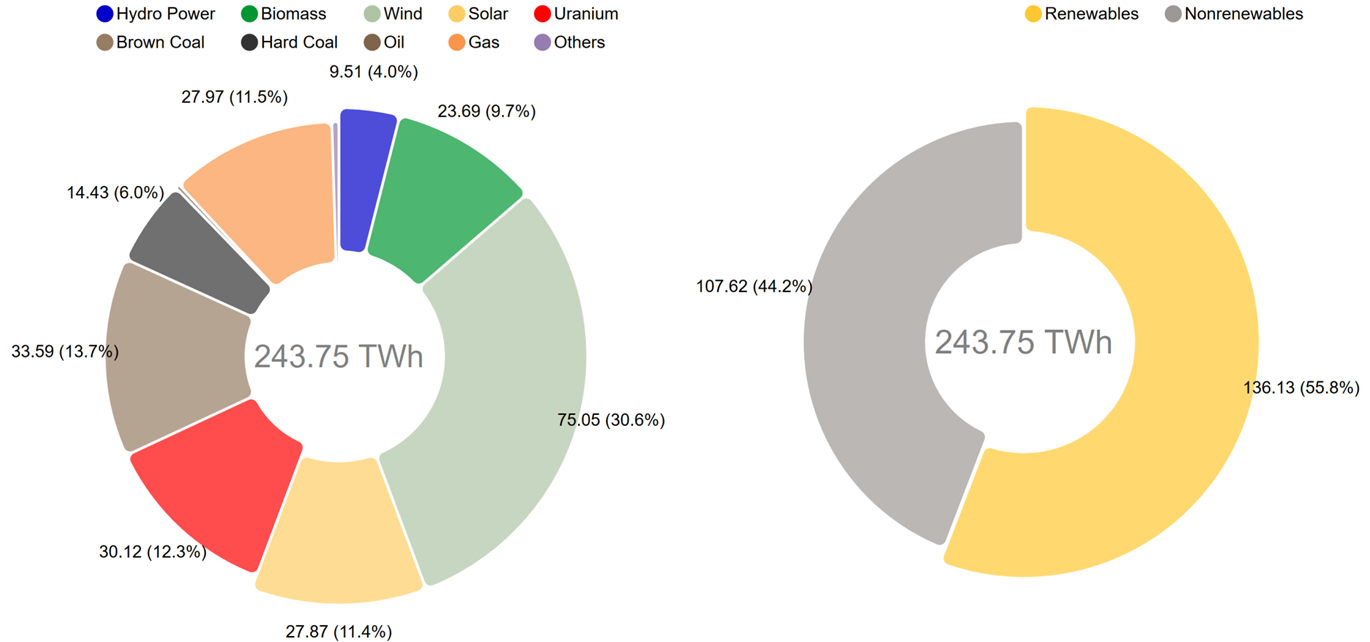Press Release #16
German Net Electricity Generation in First Half of 2020: Renewables Reach Record Share of 55.8 Percent
The Fraunhofer Institute for Solar Energy Systems ISE just presented the data on the net electricity generation for the public power supply for the first half of 2020, which is based on data available on the Energy Charts platform. At 55.8 percent, the share of renewables set a new record. In February, their share even reached a new high of 61.8 percent. In the first six months of 2020, solar and wind fed a total of 102.9 terawatt hours (TWh) into the public grid, compared with 92.3 TWh in the first half of 2019. By contrast, coal-fired power generation declined sharply, with the share from lignite falling to 13.7 percent and hard coal to just 6 percent. Wind power was again the strongest contributor, accounting for 30.6 percent.

Effects of the COVID-19 pandemic are evident
Beginning in the second quarter of 2020, there was a noticeably lower demand for electricity due to the decline in industrial production caused by the COVID-19 pandemic. In 2020, electricity consumption dropped to 35.3 TWh in June (June 2019: 37.6 TWh), and electricity production fell from 47.9 TWh in January to 36.0 TWh in June. In the first half of this year, electricity consumption was 234.2 TWh, a significant drop from 245.7 TWh in the first half of 2019. Similarly electricity production fell by 21.7 TWh to 243.8 TWh compared with the first half of 2019. Part of this decline is due to reduced exports which sank from 20.1 TWh to 7.5 TWh.
Renewable Energy Led by Strong Wind
In the first half of the year, photovoltaic systems fed approx. 27.9 TWh into the public grid, an increase of 11.2 percent compared with the previous year (25.1 TWh). The solar power systems benefited from the favorable weather conditions, which allowed more than 6 TWh of electricity to be produced per month from April to June.
Wind power produced about 75 TWh in the first half of 2020 and was thus about 11.7 per cent above the production in the first half of 2019 (67.2 TWh). Due to the numerous winter storms, its share even rose to 45 percent of net electricity generation in February. Hydroelectric production in the first half of 2020 was approximately 9.5 TWh, down 9 percent from 10.5 TWh in the prior-year period. Approximately 23.7 TWh were produced from biomass, a slight increase compared to the previous year.
In total, the renewable energy sources of solar, wind, hydro and biomass produced approx. 136.1 TWh in the first half of 2020 (previous year: 125.6 TWh). The share in the net public electricity generation, i.e. the electricity mix that actually comes out of the socket, is approx. 55.8 percent, a sharp increase compared to 2019 (47 percent). The share of renewables in the total gross electricity generation rose above 50 percent for the first time. Gross electricity generation also includes the industry's own production (companies in the manufacturing sector as well as in mining and quarrying) and the internal losses of conventional power plants. Both of these are not fed into the public power grid.
Electricity from Coal-fired Plants Falls Sharply – Switch to Natural Gas
Net electricity generation from nuclear power plants amounted to approx. 30.1 TWh in the first half of 2020, a decline of 12.9 percent compared to 2019 (34.6 TWh). In the same period, lignite-fired power plants produced about 33.6 TWh net electricity. This is 19.1 TWh or 36.3 percent less than in the first half of 2019. Net production from hard coal-fired power plants fell by 46 percent to just 14.4 TWh. This sharp decline is due to the increased price of CO₂ certificates, which averaged 21.91 Euro/t-CO₂, as well as to the sharp drop in the day-ahead exchange electricity price of 22.94 Euro/MWh on average (compared with 36.83 Euros/MWh in 2019). With an emission of about one tonne CO₂ per generated megawatt hour of coal-fired electricity, the economic viability of coal-fired power plants was hardly a given.
A fuel switch from coal to natural gas took place, due to the price for natural gas plummeting by 50 percent (8.03 Euro/MWh instead of 16.38 Euro in 2019) and the fact that natural gas power plants have lower CO₂ certificate prices.
Gas-fired power stations increased their production to 28 TWh, an increase of 13.9 percent compared with the 24.6 TWh in the previous year. In addition to the power plants for the public electricity supply, there are also gas-fired power plants in the mining and manufacturing industries to supply their own electricity. These produced an additional 20 TWh for the company's own industrial needs.
Data Sources and Information
The numbers given take into account the monthly data available up to June 30, 2020 from the Federal Statistical Office (Destatis) on electricity generation and on the import and export of electricity up to and including March 2020. The data for April, May and June were extrapolated on the basis of corrected hourly values from the Leipzig Electricity Exchange EEX and the four transmission system operators (50 Hertz, Amprion, Tennet, TransnetBW). The extrapolated values are subject to greater tolerances. Hourly updated data can be found on the Fraunhofer ISE Energy Charts: https://www.energy-charts.de/index.htm
Downloads
Last modified:
